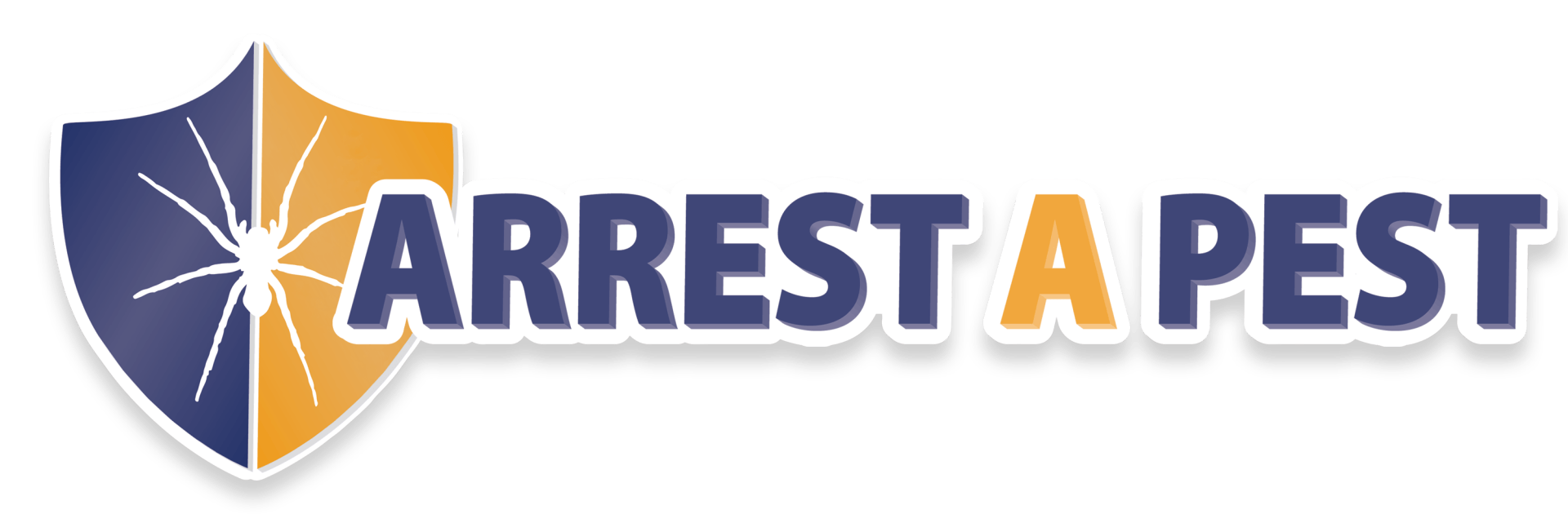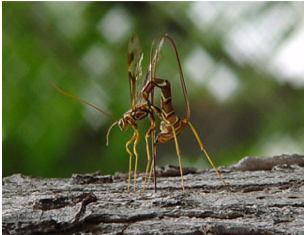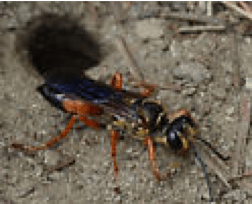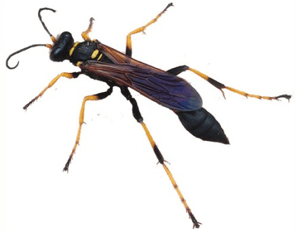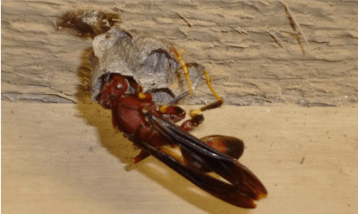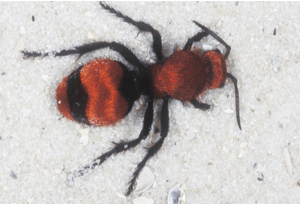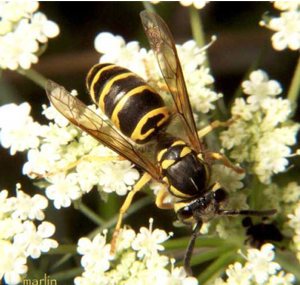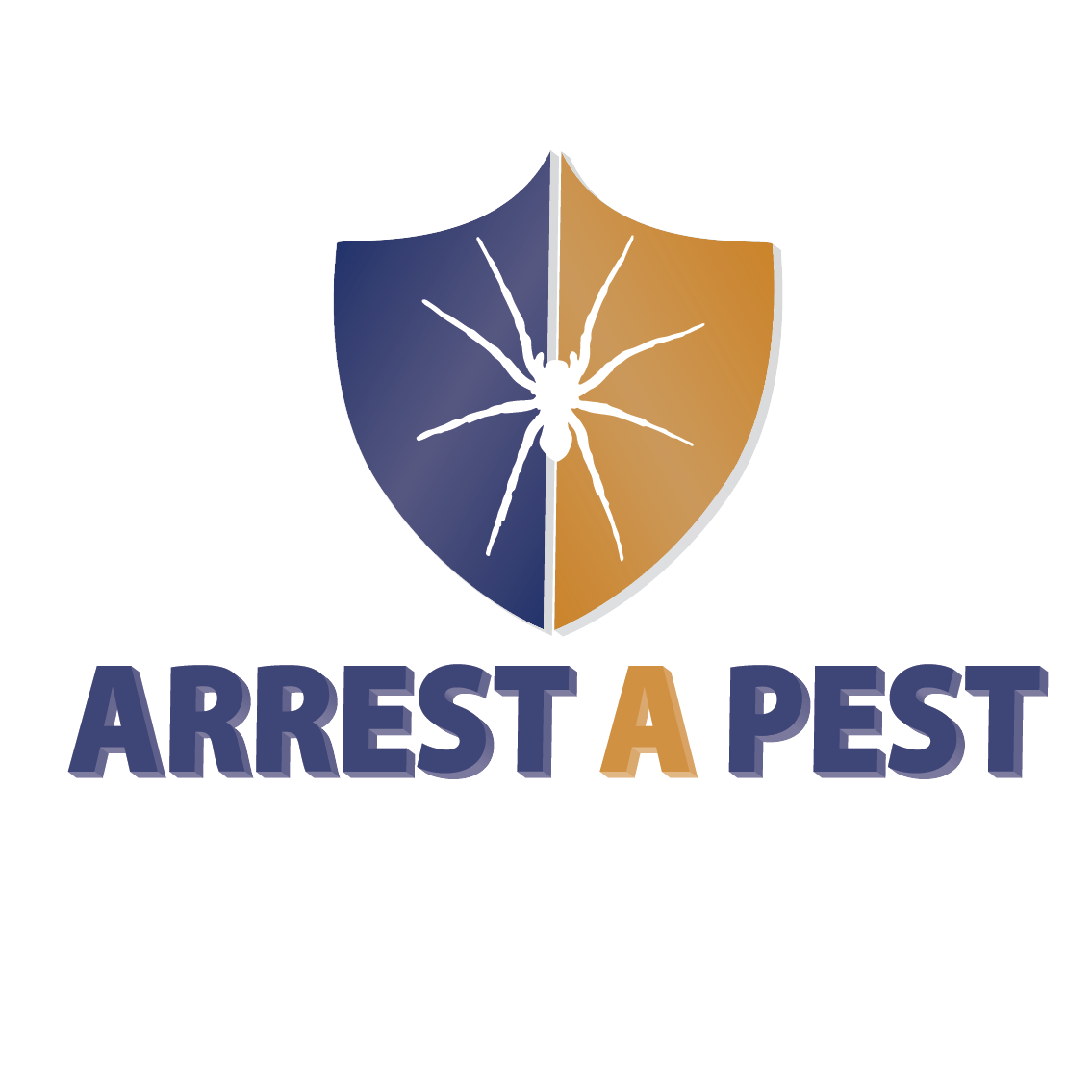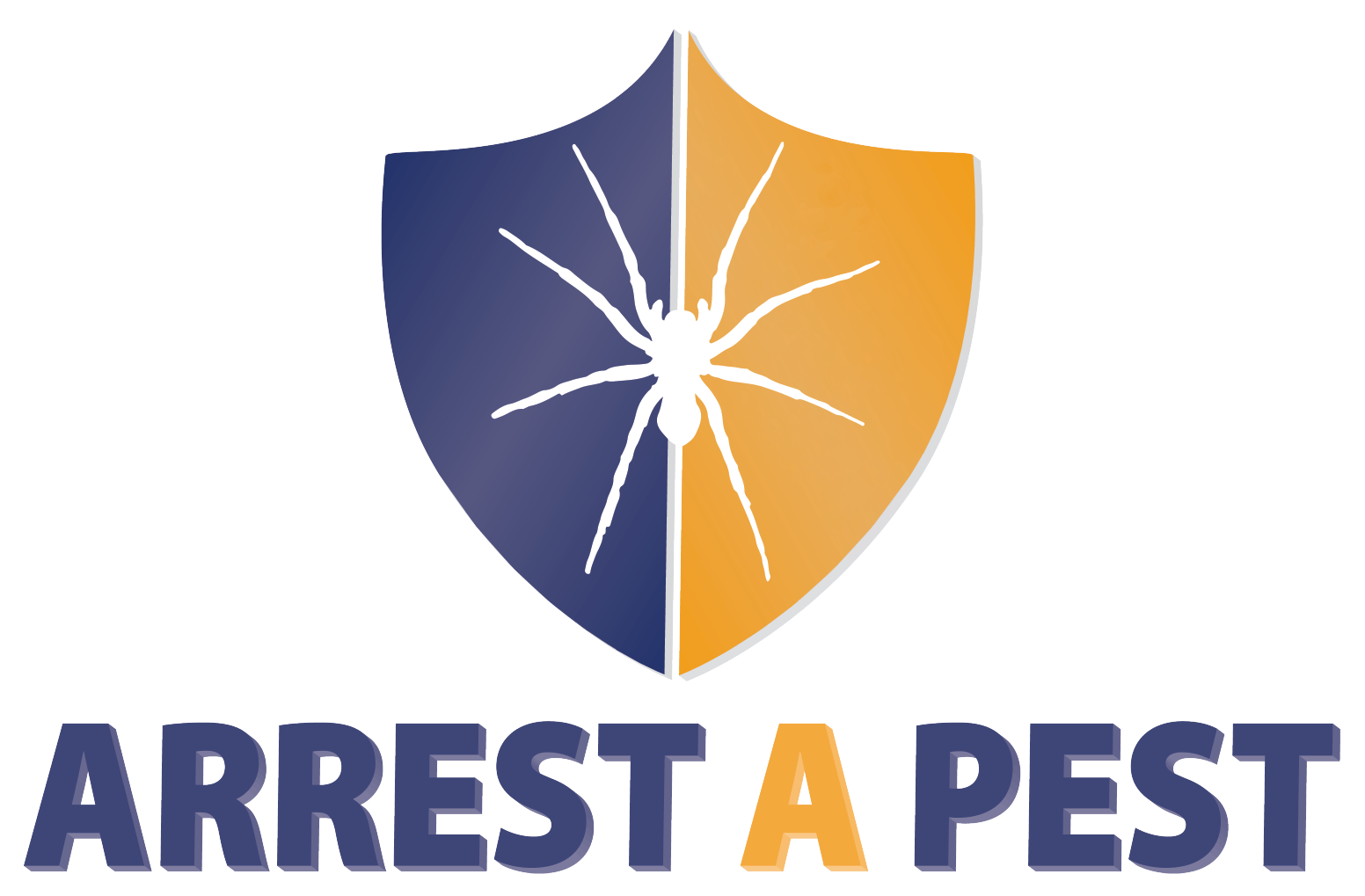Wasps
Wasps
The Quick Information On Wasps
Having a wasp problem? Check below to find out facts on types of wasps to help you get started on containing the issue.
The Quick Information On Wasps
Having a wasp problem? Check below to find out facts on types of wasps to help you get started on containing the issue.
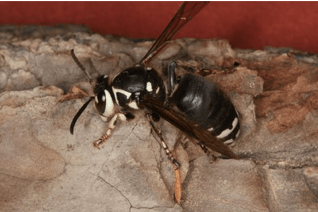
Bald-faced HornetLatin Name: Dolichovespula maculata
Alias: Baldy the Impaler
Threat Level: Medium. The sting of the Bald-faced hornet is painful, and they can sting multiple times.
Descriptions:
- The Bald-faced Hornet has white markings on its face, legs, abdomen (bottom) and thorax (back). Its size is roughly between 13mm to 20mm. They like plant nectars and sugars, but they will also eat insects.
Locations:
- The Bald-faced Hornet builds its nests in trees or shrubbery, at least 3 ft. off the ground. They will also build nests in sheds, garages, under house eaves, or other sheltered places.
Control Methods:
- Spraying an aerosol insecticide into the entrance of the nest can be an effective way to control boldfaced hornets. If intending to treat the problem yourself, it is best to do it at night, while the Bold-faced Hornets are asleep. Those with allergies and sensitivities to bee or wasp stings should hire a professional pest control service to take care of the problem.
Fun Facts about Bald-faced Hornets:
- The Bald-faced hornet is actually a Yellow Jacket.
- The Bald-faced hornet, as well as many other Yellow Jackets, makes its nests out of a mix of wood pulp and spit.
- Only female Bald-faced Hornets can sting.
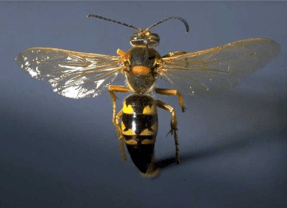
Cicada Killer WaspLatin Name: Sphecius speciosus
Alias: “Holy Cow!” (running away)
Threat Level:Low. Only the Female Cicada Killers have stingers and, although they are territorial, this wasp does not usually harm people.
Descriptions:
- Cicada Killers are back and yellow and look like a large yellow jacket. They have glossy wings about the length of their body and range in size from 1 ½ to 2 inches. This is a pretty big wasp. Only the females have stingers. Cicada Killers eat plant nectar and plant exudates.( anything that oozes from a plant)
Life Cycle:
- Cicada Killers get their name because they will attack Cicadas. This is accomplished by the female paralyzing the unfortunate cicada with her stinger and then flying or dragging it back to her burrow. There she lays an egg on it and covers it up with dirt. The egg will hatch and feed on the cicada. The larvae overwinter and emerge the next spring. There can be multiple cicada and eggs in one burrow.
Locations:
- Cicada Killers live in burrows in the soil. Since they do not like wet soil, Cicada Killers will build their nests in dry, loose dirt. Fresh nests have a u shape of loose dirt around the entrance. They can be seen in yards, golf courses, parks, flower beds, and pretty much wherever there are cicadas living.
Control Methods:
- Most wasp insecticides and sprays will be effective in treating the nesting sites. Ask your local pest control professional to inspect your property for Cicada Killers.
Giant Ichneumon WaspLatin Name: Megarhyssa spp
Alias: none
Threat Level: Low. Giant Ichneumon Wasps rarely sting humans.
Descriptions:
- Giant Ichneumon wasp’s body ranges from 1 ½ to 2 inches. They have a skinny waist and abdomen that makes up most of their body. Coloring ranges from brownish with yellow markings to bright yellow and black, depending on the species. The female Giant Ichneumon wasp has a long, needlelike tail called an ovipositor, and that can extend several inches from their body. The male Giant Ichneumon Wasp doesn’t have an ovipositor but instead has a blunt end on the abdomen.
Locations:
- Giant Ichneumon Wasps like to live near wooden areas and cover most of the United States. They dislike dry, arid conditions. You can see them outside houses around trees and wood, looking for food for their eggs. Giant ichneumon Wasps are usually active during the later months of summer.
Control Methods:
- Since Giant Ichneumon wasps are more beneficial than harmful, there are not many frequently used pest control methods. They help control other pesky garden bugs by killing them off before they mature, and are a very passive species of wasp.
Fun Facts about Giant Ichneumon Wasps:
- The female giant ichneumon wasp uses her ovipositor to drill into wood to find suitable hosts for her eggs, typically Pigeon Tremex Horntail Larvae.
- The Ichneumon family is one of the largest animal families worldwide, with over 80,000 different species.
Great Golden Digger WaspLatin Name: Sphex ichneumoneus
Alias: Golden Digger Wasp
Threat Level: Low. Golden digger wasps aren’t aggressive and generally stay out of the way.
Descriptions:
- Great Golden digger wasps range in size from 15mm to 25mm (1 inch). They are orange and black, with blackish colored wings and dark antennae. They are pollinators and feed on plant nectar and sap, but will hunt bugs such as grasshoppers and crickets for their larvae.
Locations:
- As their name suggests, these wasps dig small burrows in the ground about 4 inches deep. Golden Digger wasps are commonly found in yards, fields, and gardens. They like to nest in sunny areas with warm, dry soil and a nearby food source.
Control Methods:
- There are few suggested methods to deal with Golden Digger Wasps, as they are not typically considered pests. Often, regular pest control in your lawn and landscape areas will prevent and/or control this wasp.
Fun Facts about Great Golden Digger Wasps:
- Only female wasps can sting.
- Great Golden Digger wasps are related to the Cicada Killer.
- Great Golden digger wasps have been known to be harassed by birds as they carry the paralyzed food to their burrows.
Mud DauberLatin Name: Chalybion, Sceliphron
Alias: Dirt Dauber, Mud Wasp, Dirty Brown Sting-a-ling?
Threat Level: Low. They are not aggressive and rarely sting.
Descriptions:
- Mud Daubers are ¾ to 1 inch long and have a skinny waist that joins the abdomen to the thorax. All species have wings about 75 % the length of their body. They range in color from black, black with yellow, or blue-black, depending on their species. Mud Daubers hunt spiders to feed to their larvae.( They first paralyze the spider with their stinger, then bring it back to their nest. Afterwards, they pack it into one of the cells they’ve made and lay an egg on it.) Mud Daubers prefer spiders that make webs, but have been known to attack any spider.
Locations:
- Though the nests vary in style, all Mud Dauber nests are identifiable by their composition. They are all made of small balls of mud stuck together with even more mud to create small cells for the larvae to inhabit. You will usually find these nests in sheltered places, such as under beams, in garages or barns, attics, covered picnic areas, and even in cars or airplanes.
Fun Facts about Mud Daubers:
- There are three different species of Mud Dauber; the Black and Yellow Mud Dauber, the Blue Mud Dauber, and the Organ Pipe Mud Dauber.
- Organ Pipe mud dauber nests look like the vertical tubes of a pipe organ.
- The blue mud dauber will take over the nests of Yellow Mud daubers and fill them with paralyzed black widow spiders.
- Mud daubers have been known to pack up to 25 spiders in one cell.
Paper WaspLatin Name: Polistes spp
Alias:Umbrella wasp
Threat Level: Medium. Paper wasps can build nests near homes and gardens, and will use their painful sting if they feel threatened.
Descriptions:
- Paper wasps can be rusty red or black with yellow accents. They have smoky brown or black wings and range in size of 1 inch to ¾ of an inch. Paper Wasps rest at night, and like to feed on beetle larvae, flies and caterpillars.
Locations:
- Paper Wasps like to build nests in sheltered areas, such as in barns, under the eaves of houses, in trees, and sometimes under play equipment. They build their nests by shaping a mix of wood fibers and their saliva to form hexagonal cells, which they put larvae in. You can see Paper Wasps on flowers or in gardens, due to their status as pollinators.
- Spraying the nest with wasp freeze or another aerosol chemical is an effective way to eliminate Paper Wasp pests. It is best to do it in the evening, as paper wasps are less active and less likely to sting you.
Fun Facts about Paper Wasps:
- Paper wasps are sometimes called Umbrella Wasps because of the shape of their nests.
- Only female wasps can sting.
- A Paper Wasp queen can survive over winter to start a new colony.
Red Velvet AntLatin Name: Dasymutilla occidentalis
Alias:The Cow Killer Ant
Threat Level: Medium. They are not aggressive, although their sting is known to be incredibly painful.
Descriptions:
- Red Velvet Ants are about ¾ of an inch in length. The female Velvet Ants have no wings and are covered with small hairs, giving them a furry, velvety look. They range in color from brown, yellow or red with black stripes. The male Red Velvet Ant is half red, half black, and has black wings. When disturbed, they have been known to make a squeaking sound. They are very active during the evening hours. Red Velvet ants feed on nectar. Like many other wasps, the Velvet Ant is parasitic. When looking for a host insect for their larvae, the female targets the larvae of unfortunate ground-nesting bees.
Locations:
- Red Velvet ants can be seen crawling along the ground, usually in sandy areas or fields, but occasionally in forests or on lawns. Since these wasps are solitary wasps, they don’t have a very large nest. You’re more likely to see them during the later months of the year.
- Typically, Red Velvet Ants aren’t a huge problem for home and business owners. However, if large numbers of velvet ants are present, then taking away the open soil they nest in can help control the population. Growing more grass is also an option.
Fun Facts about Mud Daubers:
- These wasps are called ‘cow killer ants’ based on the myth that their sting is so painful that it could kill a cow.
- Velvet Ants are parasites to Bumblebees
- The stinger of the Red Velvet ant is very long, but only female wasps can sting.
- This ‘ant’ is actually a wasp
Yellow JacketLatin Name: Vespula spp
Alias: None
Threat Level: High. Yellow jackets are very aggressive and will sting repeatedly.
Descriptions:
- Identifiable by their black and yellow coloring, Yellow Jackets are about 12 mm (1/2 an inch) in size and have smoky colored wings. Yellow Jackets feed on plant sugars and nectars, and so are good pollinators. They also like sweet foods, like candy, soda, cake, and fruit.
Locations:
- Yellow Jackets build both aerial and ground nests, depending on the species. You can find them in a variety of places, including attached to trees, under the soil, around lawns and gardens and in buildings.
- Dusts applied at the exterior entrance of the Yellow Jacket nests, at night when Yellow Jackets sleep, can be an effective way of treatment. For aerial nests, spray insecticides directed at the entrance will also help eliminate the pests. People with allergies or sensitivities to wasp or bee stings should have a professional pest control company treat Yellow Jacket problems.
Fun Facts about Mud Daubers:
- Yellow Jackets are attracted to light.
- Only female yellow Jackets can sting.
Click on the links below to visit some of our industry partners
PHONE
316.945.8400
© ARREST A PEST. License Number 7113
This Website Is Powered By Silvergear© ARREST A PEST. License Number 7113
